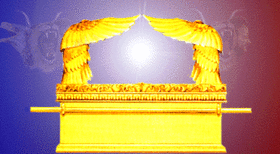
Just as no one other than the High Priest could enter the Holy of Holies and live, so the so-called “priest” in marriage is the only one blessed to enter a woman’s womb. If any other man trespasses, it means partial death to his soul and often his body, too.
Just as the Sovereign God decreed that the High Priest could only enter the Holy of Holies on the Day of Atonement, He has also set times for when the womb can be entered. In His ultimate wisdom, He has revealed to us the rightness of waiting until after a woman’s time of month is completed (Leviticus 15:19-30, 18:19). It is interesting that science has confirmed that during menstruation, a woman’s womb is too alkaline to deal with bacteria. It is seven days later when the acid begins to build back up to handle foreign substances. Obedience to the Creator’s tender instruction in this area may well mean greater health to a woman’s body!
The etymology of Atonement is “at-one-ment”. On the one day the High Priest entered the Holy of Holies to restore the people to unity with God, he could not enter without first shedding blood. According to Leviticus 18:19, a married couple is only blessed in becoming “one,” after menstruation is over (not during it). In the tabernacle on the Day of Atonement, the blood of a bull and a ram pointed to the Messiah who shed His blood to give us new life. A woman’s womb commemorates this monthly, as she sheds blood to make it possible for a new life to potentially form in her womb. Without bloodshed, a zygote could never plant itself in the womb. The uterine wall would be too thick from building up month after month. Likewise, without the blood the Messiah shed for us, it would be too hard to get a foothold on new life and abandon sinful habits. To become “one” (either with God or with man) for the purpose of a new spiritual or physical life requires blood to be shed.
The three objects contained in the Ark of the Covenant in the very center of the Holy of Holies are directly applicable to a woman’s womb. Those three symbolically valuable items were: 1) the 10 commandments, 2) Aaron’s rod that budded, and 3) the jar of manna.
The 10 commandments. The Creator designed the place of joy within a woman – her womb – to be guided by His instructions. Psalm 51:6 states, “you desired faithfulness even in the womb; you taught me wisdom in that secret place.” Blessings or sorrows always accompany commandments, based on whether they are obeyed or disregarded. The 7th of the 10 commandments found in the Ark of the Covenant lays down who can enter the womb (“Thou shalt not commit adultery”) and Leviticus 15 reveals when (not during menstruation). The 6th commandment protects innocent life in the womb (“Thou shalt not murder”). It is as though his commandments reside in the womb, much as they did in the Ark in the heart of the Holy of Holies.
Aaron’s rod. Obedience to the 6th commandment means acceptance of God’s choice in the womb, by not killing life, no matter how small. When Aaron’s rod budded, it was a sign that he was chosen by God to the priesthood (Numbers 17:1-9). The people of Israel had to accept him at that point, though they struggled to before then. In the same way as Aaron’s staff was only one out of twelve seemingly equal possibilities, at conception the number of different potential combinations for forming one new life are innumerable! Yet God reaches down and makes the selection, igniting the exact combination to be united into a person who He already knew (“Before I formed you, I knew you,” Jeremiah 1:5). When a new life has come past His throne, it is up to the people (just as it was up to the people of Israel) to accept His sovereign choice. This contemporary culture’s increasingly popular sex-selection abortions do not constitute acceptance. Nor does Denmark’s recent goal of being a Down-syndrome-free society by 2030. When the child has been created (even if the Fall has messed up things), the Creator calls for acceptance of him or her just as much as any other person.
Another connection between the picture of Aaron’s rod and sovereignly orchestrated conception within the womb also gives insight to the meaning for circumcision. It has been said that circumcision causes potential children (corresponding to the sprouts and almonds on the rod) to pass through a sign of the covenant between God and man (Genesis 17:11). Circumcision identifies potential children as God’s, just as Aaron’s rod identified him as God’s choice!
The jar of manna. Womanhood can be tough. It can feel like a wilderness with painful monthly cramps, bloody messes, raging hormones and emotions, and the rigors of labor and delivery. The jar of manna housed within the Ark of the Covenant shows the tender daily provision the Heavenly Father has granted for “womb-men.” He grants endurance and His sustaining strength for today, for right now. Trying to gather several days of manna did not work for the children of Israel, and it is just as useless now when it takes the form of worry about making it through a childbirth or difficult time of month. However, gleaning daily from His Word – the manna of life – will give us exactly what we need to make it through, moment by moment.
A woman’s life may have difficult moments physically and/or emotionally. There will be shedding of blood. There may be menstrual pain or pain in delivery. But it is all for the purpose of new life. If his commandments guide our inmost being, and we have responded to the calling of Aaron’s staff - to be His people - then His presence will dwell in us like the thick cloud over the tabernacle. There will be daily manna to get us through with joy! He designed it to be so! He has placed a miniature Holy of Holies within us!

 RSS Feed
RSS Feed